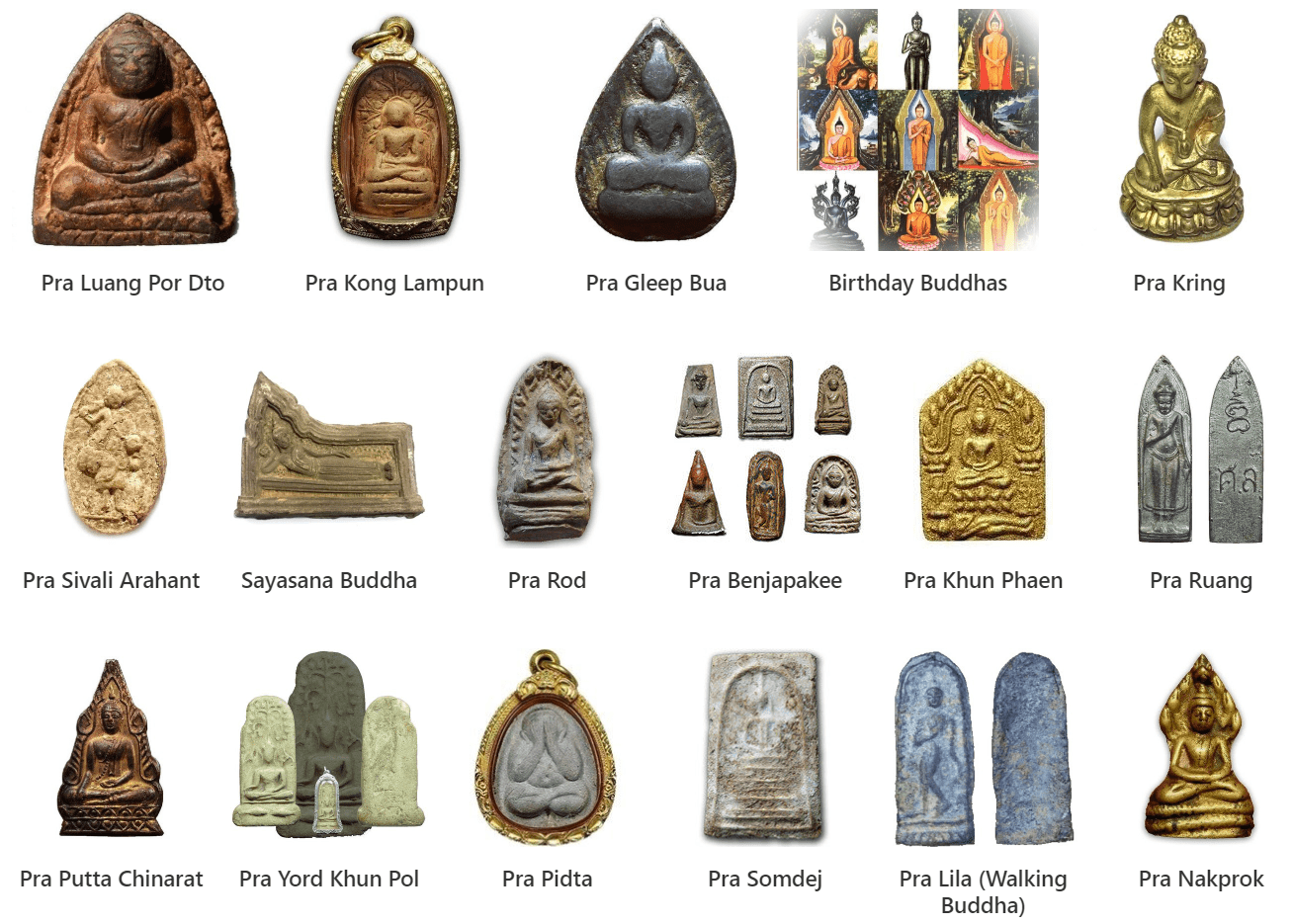Famous Thai amulets [ edit ] 403
by Admin
Posted on 09-11-2023 11:40 AM

Thai buddhist amulets are something of an obsession in this buddhist land. Buddhist amulets are part of thai culture and you see them everywhere. Amulets, on the other hand, ward off evil and repel bad luck. The word itself comes from the latin amuletum, ‘to protect a person from trouble”.
 They can be gems, paintings, rings or pendants, animals, and even words. (talismans, a related form of what we call ‘charms’ bring luck). In most treasured form, the buddha amulet, is known as plah keang. During a deadly drought a thai monk went to the disaster area during a deadly drought to
rescue
a famous statue of gautama that was in danger of being abandoned.
They can be gems, paintings, rings or pendants, animals, and even words. (talismans, a related form of what we call ‘charms’ bring luck). In most treasured form, the buddha amulet, is known as plah keang. During a deadly drought a thai monk went to the disaster area during a deadly drought to
rescue
a famous statue of gautama that was in danger of being abandoned.
The steep pricing of sacred objects originating from temples has also given rise to another huge market known as “phrakherung khorng rongngan” in thai which literally means “factory amulets. ” in the past, these are confined to counterfeit copies of original amulets originating from temples. However, innovation within the business industry has also brought new life -lines to factory amulet market. There have been a group of businesspeople who have came up with ingenious idea and entered into partnership with various less known temples and monks whereby those businesspeople will make amulets in the name of those temples and monks and sell them to especially unsuspecting foreigners at ridiculously cheap prices which are below value x when calculated using the above given formula.
This 103-page compendium, written in thai language, is a treasure trove of rare and famous pra pid ta amulets crafted by great masters of metallurgical alchemy, including world-famous sorcerer monks and lesser-known but equally powerful masters. With classic pra pid ta amulets from various masters and temples, this book serves as an excellent reference material for authentication and recognition of these rare and highly valuable amulets. It also provides a fascinating study of thailand’s grand pantheon of pra pid ta from a myriad of masters throughout history. But what sets this book apart is its enchanting presentation. It’s a fantastic pictorial study of cast metal ‘loi ongk’ statuette type buddha amulets and talismanic animist charms.
Two new arrivals of sacred thai takrut amulets arrived in store today, of great deceased masters. The highly renowned black laquered with gold leaf takrut kong grapan chadtri, and red laquer with gold leaf cord bound takrut metta of luang por jamlong (wat chedi daeng), and a rare example of the famous chueak takrut koo ud look sakot nuea dtakua double takrut with 6 look sakot alchemical leaden alloy magic seal beads, on cord belt/necklace, from the legendary luang por koon, of wat ban rai below; chueak takrut koo ud look sakot nuea dtakua luang por koon wat ban rai this twin takrut tone tong daeng compendium wicha, with 6 look sakot spellbinder beads in alchemical leaden alloy, from the great luang por koon, of wat ban rai in nakorn rachasima, is an early era amulet, and an extremely rare artifact to encounter in any circumstance.
Prayer [ edit ]
Omamori ( 御守 / お守り ) are japanese amulets commonly sold at shinto shrines and buddhist temples, dedicated to particular shinto kami as well as buddhist figures, and are said to provide various forms of luck and protection. Origin and usage[ edit ]
the word mamori ( 守り ) means 'protection', with omamori being the sonkeigo (honorific) form of the word.
 Originally made from paper or wood, modern amulets are small items usually kept inside a brocade bag and may contain a prayer, religious inscription of invocation. Omamori are available at both shinto shrines and buddhist temples with few exceptions and are available for sale, regardless of one's religious affiliation.
Originally made from paper or wood, modern amulets are small items usually kept inside a brocade bag and may contain a prayer, religious inscription of invocation. Omamori are available at both shinto shrines and buddhist temples with few exceptions and are available for sale, regardless of one's religious affiliation.
See also [ edit ]
Lp opasi was born in 1898 and hade 7 siblings. He began hes monastic studies at 5 years of age and became a novice at wat tai at age 13. Hes teacher noticed that he was a gifted student and advised him to go to a larger city to complete his studies, which made the young lp opasi travel to wat tah-po, and then to bangkok to study pali in wat bawon. Lp opasi liked to study and learned several languages. He spoke english, tamoul, malai, japanese, pali and several other languages. He was the disciple of the very worthy lp kob (a monk of chinese extraction to the miraculous capacity) of wat koa salika in lopburi.
34. 4mb | tiff unlimited seats this license extends our regular royalty free / editorial license to an unlimited number of seats within the same organization. It is an additional license to the usage included within the regular royalty-free / editorial license that awards rights for a single person within the same company. The u-el license is applied only for the staff of the organization that holds the account. The number of copies allowed is unlimited for each designer/employee. Web usage electronic items for resale/distribution: this license includes the right to use the media in webtemplates that are sold to more customers, screensavers, e-cards, powerpoint presentations or as wallpapers on cell phones.